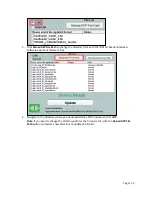
Page | 15
6
Electronic Design
6.1
Power Supply
The SmartPIN L100 supports three different modes:
•
RS232
– Requires power supplied by an external A/C power adapter (5VDC).
•
UART
- RJ45 cable connects directly to the Spectrum Pro insert reader; also requires an external
A/C power adapter (5VDC).
•
USB
– Connects directly to the host, which provides power through the USB interface.
6.2
USB - Power supplied through USB port Power Management
Power management includes several parts:
1.
System voltage supply
a.
An LDO chip is used to convert 5V external voltage to 3.3V, which is the common voltage
for all chips and components used in this device.
2.
Battery
a.
A battery supplies the power for the SRAM to keep the keys in storage.
6.2.1
Low Power Mode
In low power mode, the voltage of all peripherals is cut off and wakes up by key press and
communication from PC.
6.3
Reliability & Environmental
MTBF: 425010 hrs (FR=2352 FITs, BasicR=0.979)
FR is failure rate. FITs is failures per billion hours. MTBF is the Mean Time between Failures in hours.
BasicR (Reliability) is the probability that the circuit, taken as a purely Serial configuration, will operate
without failure for the mission time. For example, if the BasicR = 0.837438, then
the circuit has a probability of 0.837438 (or 83.74%) of working without a failure for the mission time
duration.
6.3.1 Electro-Static Discharges (ESD)
The L100’s electronics can survive electrostatic discharges of 6kV contact and 12kV air discharge with no
loss of communications, per ID TECH ESD testing procedures.
6.3.1
Environmental Temperature Range
Operating
-25 to 70
°
C (-13 to 158
°
F) [non-condensing]
Storage
-30 to 80
°
C (-22 to 176
°
F) [non-condensing]
Relative humidity:
Maximum 95% (non-condensing)
6.4
Agency Certifications
FCC CLASS B & CE PCI 4.1
















































